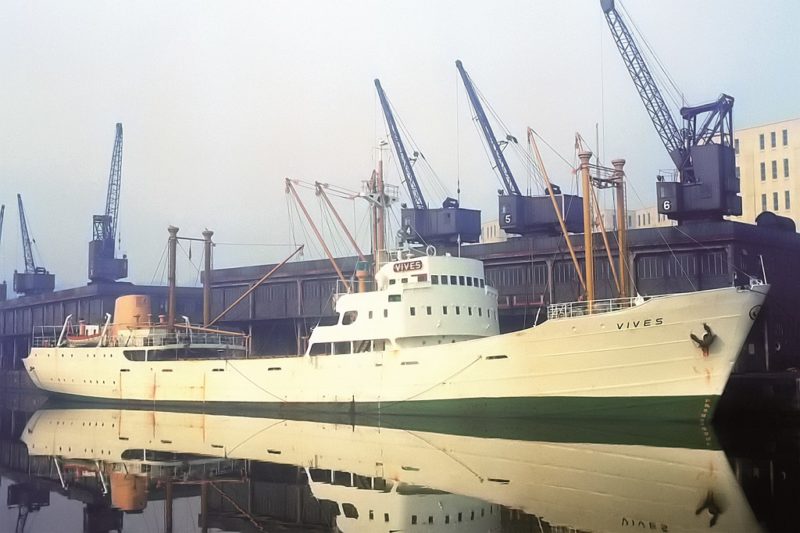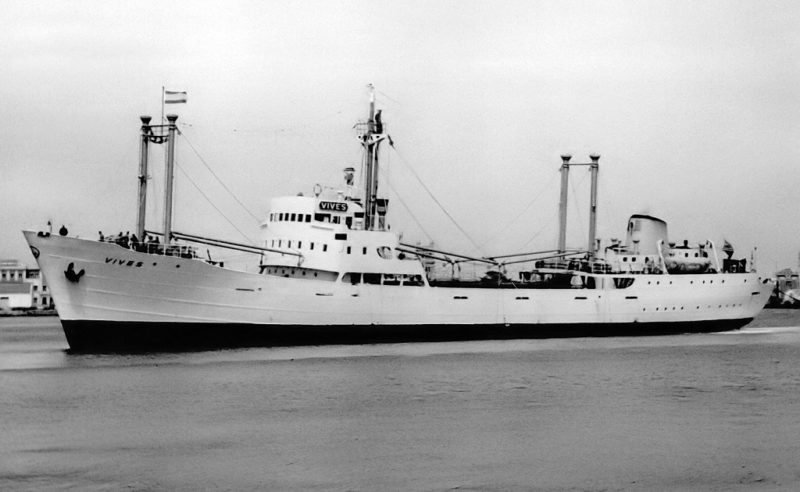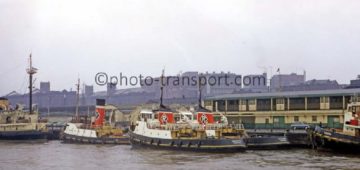
In the 1960s and early 1970s, jobs at sea for marine engineers were fairly easy to secure. The normal route was by applying directly to a shipping company or to see what was on offer at the local British Shipping Federation (BSF) pool. The pool was a useful refuge for registered seafarers in finding a ship at short notice. I visited the BSF at Prescott Street, London in August 1970 and was soon offered a position as fourth engineer on mv Vives, a MacAndrews Line ship, berthed in the West India Dock. When I arrived onboard I was directed to the aft accommodation which housed the engineers. I soon realised that I was in the right location by the oil-stained deck in the alleyway. It appeared that the engine-room staff had a marked aversion to removing their boots when leaving machinery spaces. I found the chief engineer, Mr Levy, a small bespectacled man from Glasgow who led me to the second engineer’s cabin. He introduced me to the second engineer, Brindley Jones, who was a stocky Welshman from Montgomery-shire. After donning my boiler suit, I walked around the ship with Brindley, who preferred to be called Brin. He introduced me to the company’s shore-side engineer, named Bruno, who was originally from Poland. His vocabulary was rather colourful, in that every other word was an expletive. He was at the time in his element removing some nuts from a cover using a spanner with the aid of a hammer. Nearby lay a large cold-chisel to supplement his efforts. The general state of the engine-room came as quite a revelation to me after previously sailing on two Ben Line ships where the machinery spaces had kept been spotlessly clean by a Chinese crew.
In the engine-room was the third engineer Brian O’ Malley who was a motor mechanic by trade. He hailed from Plymouth and was there to accumulate some money quickly. As a consequence, he mainly stayed onboard. Later, I met the electrician, Bob Day, who had sailed for many years with Shaw Savill Line and whose last ship was the ss Ceramic. At 24 years old, it seemed I was by far the youngest member of the engineering staff, as all the others were aged around 40 or over with a wealth of sea-going experience. The engine-room was permanently manned by three donkeymen on continuous watches of four hours on and eight hours off.
The 1,216grt Vives, was one of three sister ships built for MacAndrews & Co. Ltd., London, and was completed by her builders Krogerwerft at Rendsburg in October 1955, the other two being Valdivia and Villegas. Propulsion was by twin, eight-cylinder, MWM diesel engines driving a single screw, which produced 2,000 bhp to give the ship a speed of around 14 knots. Their cargo capacity was around 1,600dwt with one hold forward of the bridge and one larger hold aft.
The ship had a complement of 25 men, comprising a captain, three deck officers, a radio officer, bosun, six deck ratings, a chief engineer, three watch-keeping engineers, an electrician, three donkey-greasers, a chief steward, a cook, two assistant stewards and two 16-year-old catering boys. Today, a vessel of a similar tonnage would have a Safe Manning Certificate with barely a third of this number.
MacAndrews adopted ‘Section B’ of the Hours of Agreement, which meant an overtime payment for hours worked over the basic eight-hour day, and for every Sunday and public holiday spent at sea, but this came with fewer days’ leave and no entitlement to paid study leave. My basic pay was £97 17s 6d per month which included a payment of £5 per month for the exemption from Part A of the Second Engineers’ Certificate. The monthly pay scales for the others in the engineering department were, second engineer (uncertificated) £133, electrician £114, third engineer £104 and the donkey-greasers £66. These pay rates were after the maritime unions achieved the largest-ever pay increase of 20% in the spring of that year.
Most afternoons in London we finished work early and congregated in the second engineer’s cabin for a few beers. A lot of banter was exchanged and wondrous stories were told about their experiences. When the beer cans were empty, it was normal practice to pierce the bottom of the cans with the top-end spanner which is what we called the can opener before casually disposing of them out of the open sidescuttle. At that time, the general feeling was that providing the cans sank quickly and didn’t float around the dock, then everything would be alright.

In the evening, Brin and I would take a walk up the road to his favourite pub called the Five Bells opposite Limehouse church. Brin had a habit of taking two packets of 20 cigarettes together with an empty stamped addressed envelope through the dock gate. He knew the dock police would not challenge him on that small amount of duty-free cigarettes, and at the first opportunity posted them to his father in Wales.
After over a week alongside, the ship departed for a three week voyage calling at Lisbon, Casablanca, Cartegena, Valencia, Cadiz and Lisbon again on the way home. We left the West India Dock on the evening tide. It was my first trip in charge of a watch and being aware of this Brin gave me the long-serving and experienced donkeyman by the name of Lopez, whose family had come to the UK to escape the Franco regime in Spain. The chief engineer came down for departure wearing his usual black trousers, dark shirt and matching shoes. Unlike today, in those days safety gear such as boots and ear defenders were not mandatory. Upon starting the main engines, I noticed a lot of smoke billowing from the top of the exhaust manifold on the starboard engine. The chief engineer was quite nonchalant and appeared to have seen it all before. We were soon on standby and by now the engine-room was completely filled with smoke. The chief engineer decided it was time to rectify the situation by dragging the purifier fresh-water hose towards the starboard engine. He turned on the cold water and then quite merrily hosed down the entire exhaust manifold generating a lot of smoke and steam. I was a bit shocked by his cavalier attitude to the likelihood of the exhaust manifold cracking or distorting due to temperature stress. I said to him, “What are you doing chief?” He replied, “Och, you’ve got to keep it cool.” To my surprise, the smoke did eventually disappear from the engine-room with no apparent adverse effects on that engine.

The engine-room ventilation was by natural draught cowl vents, supplemented by skylights situated on the boat deck. For a good flow of air down below, it became one of the donkeyman’s routine jobs to go on deck and turn the cowl vents into the wind. On the morning watch, it was a nice feeling to walk around the engine-room with bright sunlight streaking through the open skylights.
During the watches at sea it was customary to accumulate overtime by working in the engine-room doing some deferred maintenance work on items such as lapping-in valves on spare cylinder heads or overhauling fuel injectors in the workshop. Towards the end of each watch the logbook was filled in. This task did not take me too long after discovering that numerous pressure and temperature gauges were either missing or defective. The last and most important job before noon on the 8 to 12 watch was to take the daily oil soundings for the chief engineer to scrutinize. If anything was amiss there would soon be a knock by him on your cabin door!
Our first port of call was Lisbon for a day to discharge cargo. Berthed nearby was an ageing Portuguese troop ship, there to carry many hundreds of young Portuguese conscripts to hold on to their empire in Africa. I was later informed by a Portuguese man that they did not have colonies but overseas territories that were an integral part of Portugal. After my watch, I took a walk up the road. Brian, the third engineer, gave me some sound advice when using public transport in poorer countries, which was, “Don’t worry about the language, simply buy the highest value ticket and get off the bus or tram where you want to, it will be so cheap anyway”. It was an interesting experience riding the wooden trams through the narrow streets of Lisbon. Some of these old trams are still operating today presumably for nostalgia and the lucrative tourist market.
The next port was Casablanca, where the ship was berthed not far from the phosphate loading terminal. Clouds of dust could be seen rising from the bulk carrier being loaded. It was not long before a thin layer of phosphate dust began to appear on the ship’s superstructure, During the lunch break, we decided to take a short walk up the road. One of the few unpleasant experiences on the trip occurred when we were confronted by a group of irritating touts. They were so quick and well organised that I did not realise that all my money had been whipped out of my pocket. Back onboard ship, one of the Moroccans had brazenly stolen the engineers’ teapot from the pantry, and it was later reported that they even managed to remove some of the brass nuts from the winches.
That afternoon, the ship sailed to the Mediterranean and the Spanish naval port of Cartegena where some vintage World War Two warships were seen at anchor. We arrived there early morning for a full day alongside. Brin was a ‘job and knock’ man who wanted to be up the road no later than after lunch. Our last job of the morning was to change the fuel injectors on one of the main engines. It was going to be a team effort with me cleaning the injector pockets, Brian putting the overhauled injectors back in and Brin re-connecting the fuel pipes. The injector pockets were cleaned with the aid of a piece of rag attached to an aluminium top at the end of a short broomstick. As I was enthusiastically cleaning one of the pockets, the broomstick came out leaving the rag and aluminium top jammed inside. Seeing this, Brin was so angry that I received a tirade of verbal abuse. Meanwhile, Brian was trying desperately to lever the rag out, but without success. Brin then yelled at me to open the main starting air valves in order to blow over the engine. He then went down to the engine controls and shouted at everyone to get down. As the engine began to turn over I heard this loud bang which was immediately followed by the aluminium top ricocheting around the engine-room. Then Brin said to us with a wry smile on his face, “Get this job boxed up and let’s get up the road!” This unorthodox but effective way of removing a wedged object from a cylinder head, could have easily resulted in injury to those foolish enough to remain in the engine room. But, by a stoke of good fortune, this did not happen.
Further up the coast was our next port, Valencia. On entering the harbour, an enterprising photographer took a picture of the ship (shown above). Later in the day he came onboard to sell the photographs enclosed in an embellished card. One of the jobs for that day was a main bearing survey on a main engine. Everything was proceeding quite well until it came to re-connecting the lubricating oil pipe to the top of the main bearing keep. Brin and I were working from either side of the engine crankcase and since the oil pipe was mainly on my side, it was for me to complete the job. Somehow the pipe must have previously become distorted and no matter how much I tried I just did not have the strength to screw the pipe back onto the bearing keep. All of a sudden, I felt this hand on my boiler suit collar pulling me out of the crankcase with Brin saying, “Get round the other side”. To my astonishment, I saw him, with sweat streaming down his face, physically bend the pipe onto the oil aperture on the bearing keep and screw the nut down with his bare hands. He looked at me and said with a big sigh of relief, “That’s how you get the job done!” After the pipe connections were tested for leaks, we were finished until the ship’s early evening departure.
The runs ashore along the Spanish coast were relatively cheap, especially when visiting the bars used by the locals. In one back-street bar, I can remember small glasses of sherry poured from a row of oak barrels being two pesetas. This price seemed unreal at the prevailing exchange rate of about 165 pesetas to the pound.
On arrival in Cadiz, the Port Health Authority found some irregularity with the crew vaccination certificates and, as a consequence, quarantined the ship with no shore leave allowed. From here, we sailed to Lisbon for a short evening stay. Fortunately, there was enough time to walk up the road to do some shopping and have a final drink before departing for London.
The ship arrived back in the West India Dock in mid-September where I reluctantly paid off to go back to college. It was such a harmonious and easy-going ship that I would like to have stayed on and completed her last voyage under the Red Ensign to Malta and Cyprus. At the end of October, the ship was handed over to Italian buyers and renamed Nevis. She ended her days trading as Andros Island under the Maltese flag. In June 1986, whilst laid up in Karachi, she was wrecked after parting from her moorings during strong monsoon winds.
On leaving the ship, I consoled myself in thinking that trips like this would always be around. I knew that container ships were on the horizon, but what really took me by surprise was their rapid implementation. I am glad to have experienced life onboard the conventional cargo ships and to have met many of the colourful characters that once made up the seafaring community.




Comments
Sorry, comments are closed for this item